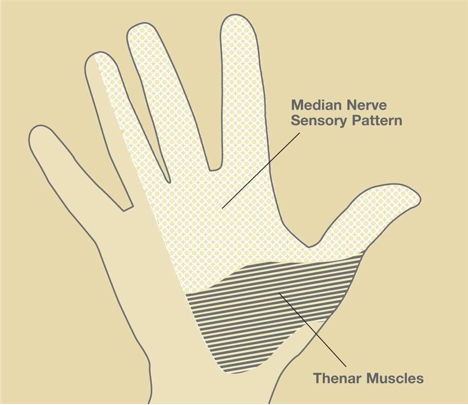Carpal Tunnel Syndrome (CTS) is a common problem caused by increased pressure on the median nerve at the wrist. The carpal tunnel is an area in the wrist in which the median nerve and nine tendons pass from the forearm to the hand. Flexing and extending the wrist narrow this space, which compresses the nerve and can cause symptoms.
Carpal Tunnel Symptoms
The most common symptoms include pain, numbness, and/or tingling in a portion of the hand. Symptoms usually fluctuate depending on the positioning of the wrist. With more severe carpal tunnel syndrome, numbness can become constant and weakness may develop.

Symptoms are usually more prevalent with activities such as sleeping, computer use, driving, and while talking on the phone. These are the activities in which the wrist is flexed or extended, causing narrowing of the carpal tunnel, and placing pressure on the nerve.
Carpal Tunnel Treatment
Splinting – Wearing a splint at night is often the first line of treatment. The splint will prevent the wrist from flexing or extending at night. In mild cases, this may provide complete relief of symptoms.
Steroid injections – Injections accomplish multiple objectives. Most importantly, they typically are very effective at providing relief from the symptoms of CTS. Second, they confirm the diagnosis of carpal tunnel syndrome. Unfortunately, these injections usually are not a cure. On average, they provide approximately a few months of relief, but this can vary greatly from patient to patient. Obtaining relief from an injection typically means surgery will provide similar relief.
*It is important not to ignore the symptoms of carpal tunnel syndrome. We recommend surgery in patients experiencing constant numbness, tingling or weakness. Once symptoms progress to such a level, they may not recover due to nerve damage.
Carpal Tunnel Surgery
Surgery involves releasing the carpal tunnel. This is done by cutting a ligament (the transverse carpal ligament) that lies over the top of the nine tendons and the median nerve. The ligament heals with more space in the carpal tunnel. There is no loss of function from cutting this ligament. This will decrease the pressure on the median nerve immediately. Many patients sleep better the night after surgery than they have in months.
We offer two different treatment options for surgery.
1. Endoscopic Carpal Tunnel Release
2. Mini Open Carpal Tunnel Release
Endoscopic Carpal Tunnel Release
Endoscopic Carpal Tunnel Release (minimally invasive carpal tunnel release) involves placing a camera into the carpal tunnel through a single small incision in the wrist. Under direct visualization with the camera, the transverse carpal ligament is released.
The procedure is performed in a surgery center under a light general anesthesia. The small incision is closed with a single small stitch under the skin. The dressing is taken off the next day and motion is encouraged. We limit lifting for 2 weeks and then progress as tolerated.
Mini Open Carpal Tunnel Release
This technique involves an incision in the palm of the hand. The incision is approximately 1 to 1.5 inches in length. The transverse carpal ligament is visualized and released, taking the pressure off of the median nerve. The skin is closed with several stitches and a small dressing is placed. This procedure can be done under local anesthesia, also known as Wide Awake Surgery.
Diagrams modified from ASSH (www.assh.org)

